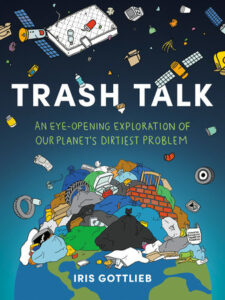The image most of us probably think of when we imagine Earth from outer space is that classic photo, The Blue Marble, taken from the Apollo 17 mission in 1972. Floating majestically in a sea of infinite black, Earth sits pristinely against the background. That photo was taken from a space mission to land on the moon. Our image of Earth’s pure, unmarred place in the stark darkness of outer space is not quite as accurate these days.
We have been polluting Earth’s land and sea for decades, but since the launch of Sputnik 1—the first artificial satellite—in 1957, our trash has expanded to outer space. As humans travel further and more frequently into space, we leave more and more debris in our wake. From the tiniest flecks of paint to large defunct satellites, our orbital litter is beginning to pose real problems for the health of space and Earth as it becomes a rotating landfill above us. I believe outer space is just as entitled to its own health and well-being, even if it’s not a living, breathing ecosystem like ours.
It has become a tragedy of the commons: an unregulated public resource that becomes overused, depleted, or exploited due to individuals, corporations, or governments acting in their own self-interests, to the detriment of the common good. Earth’s orbit is now home to national space missions from dozens of countries and satellites owned by the private sector, which contribute to the fastest-growing increase in satellite traffic.

As humans travel further and more frequently into space, we leave more and more debris in our wake.
Private companies are quickly introducing “megaconstellations”: fleets of communication satellites in low orbit, far outnumbering scientific or research vessels and posing a risk of congestion and collision. SpaceX, the space exploration and technology company started by Elon Musk, has developed a high-speed internet service called Starlink and is sending up satellites by the thousands. As of 2023, Starlink has launched five thousand satellites, has approval for eleven thousand more, and has requested an additional thirty thousand from the Federal Communications Commission.
An estimated 10 percent of Starlink satellites in orbit will soon be nonoperational, beginning a slow process of planned removal from orbit, and sending tons of material into the atmosphere every day as they fall from space. Because Starlink dominates Earth’s lower orbit, it’s also the culprit of most near misses with other orbiting objects, heading toward a rate of 90 percent of all near misses.
While some orbital debris is programmed to return to Earth’s atmosphere once defunct, some of this dumping is intentionally planned to stay in space, and some is a by-product of missions that have returned. The various missions to the moon have left behind over four hundred thousand pounds of trash on its surface, and the amount of garbage orbiting Earth is staggering. According to NASA, there are more than twenty-three thousand pieces of junk greater than a softball, five hundred thousand pieces greater than a marble, and over one hundred million pieces approximately one millimeter in size.
From tiny fragments of material to bigger remnants crashing into other junk, it all can cause major problems for active equipment orbiting Earth. Even the smallest pieces can have damaging effects at speeds of around 15,700 miles per hour. The impact of these objects can cause items to fall back to Earth or break satellites, which in turn become more defunct space junk. For instance, in 2007, a Chinese missile was sent to intentionally destroy an old satellite and resulted in over 3,500 new pieces of orbital debris. This debris will eventually hit other objects that will break apart and hit other objects that will hit other objects, and the process will continue indefinitely, exacerbating the issue and limiting the potential to clean it up.
Along with the potential (and reality) of debris causing damage to other orbiting objects, scientific research is being jeopardized—satellites in orbit are at risk for physical damage, and both satellite and ground research experience light pollution that impedes exploration. Attempts are being made to address the issue and implement cleanup strategies, ranging from sending defunct objects into higher orbits to declutter the active orbit zone, to developing satellites that will latch onto objects, removing them from independent orbit. While these are useful ideas and ones that can be put into place, the scale of debris is worsening, and the technology to clean it up is not matching the pace of debris creation.
I believe outer space is just as entitled to its own health and well-being, even if it’s not a living, breathing ecosystem like ours.
Not to mention, the smaller the debris is, the harder it is to collect. Imagine trying to pull a fleck of paint out of orbit. It’s a similar undertaking to ridding the ocean of microplastics. Not all the garbage we’ve put in space is orbiting—some of it is littering Mars and the moon. There are currently almost sixteen thousand pounds of dead equipment and remnants of crashed spacecrafts on the surface of Mars, and most if not all will remain there until they break down, which will likely never happen. Unlike the risks posed for communication satellites in orbit, Mars’s litter doesn’t negatively affect any daily functions on Earth.
But it’s a glaring representation of humanity’s desire to conquer and explore exceeding our desire to respect the spaces we occupy, even if those uninhabited spaces are 53.4 million miles away. Similar to how we treat the ocean, we regard the places we can’t see or use as fair game to be dumping grounds. Outer space is an untouched, mysterious place, and it seems to me that humans want ownership of it, even if it comes at the price of tarnishing what’s not ours to take. Just because no humans are there doesn’t make it ours.
When it comes to the moon, it’s no surprise that on missions to essentially conquer it, astronauts from the many countries that have landed manned or unmanned missions to the moon have left loads of trash there (as of 2022, eight countries have littered on the moon).
A Partial List of Items on the Moon
Five American flags (seems like overkill)
Ninety-six bags of vomit and human waste
Three rovers
Various tools
Improvised javelins
A family photo
Two golf balls
A disk containing messages from the leaders of seventy-four countries
The video camera that captured the famous video of astronauts on the moon’s surface
Some of this is equipment that was discarded so moon rocks could be brought back on the ship; some of it was purely in the name of fun, such as golf clubs; and some of it was sentimental, like family photos. Leaving flags or bags of vomit has the same end result, even if one seems explicitly patriotic—it is symbolic of the desire to colonize what we feel entitled to take. This evidence will remain in place forever until it is bleached to an unrecognizable state by UV rays, taken by aliens, or exploded in a cosmic collision.
__________________________________






